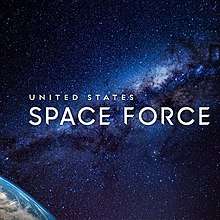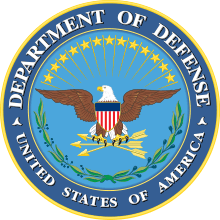United States Space Force
The United States Space Force (USSF) is the space warfare service branch of the U.S. Armed Forces, and is one of the eight U.S. uniformed services. Initially formed as Air Force Space Command on 1 September 1982, the Space Force was established as an independent military branch on 20 December 2019, with the signing of the United States Space Force Act, part of the National Defense Authorization Act for 2020.
| United States Space Force | |
|---|---|
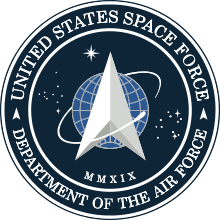 | |
| Founded | 20 December 2019 (as an independent service) 1 September 1982 (37 years, 9 months as Air Force Space Command)[1] |
| Country | |
| Type | Space force |
| Role | Space warfare |
| Size | 88 active duty Space Force members[2] 16,000 assigned airmen[3] 77 spacecraft[4] |
| Part of | |
| Headquarters | The Pentagon Arlington County, Virginia, U.S.[1] |
| Anniversaries | 20 December |
| Website | www |
| Commanders | |
| Commander-in-Chief | |
| Secretary of Defense | |
| Secretary of the Air Force | |
| Chief of Space Operations | |
| Vice Commander | |
| Deputy Commander | |
| Senior Enlisted Advisor of the Space Force | CMSgt Roger A. Towberman |
| Insignia | |
| Flag | 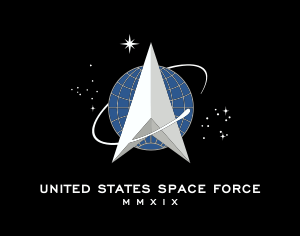 |
| Part of a series on the |
| Space policy of the United States |
|---|
 |
|
Human spaceflight programs
|
|
Robotic spaceflight programs
|
The U.S. Space Force is organized as a military service branch within the Department of the Air Force, one of the three military departments within the Department of Defense. The Space Force, through the Department of the Air Force, is headed by the Secretary of the Air Force, who reports to the Secretary of Defense, and is appointed by the president with Senate confirmation.[5] In terms of personnel count, it is the smallest U.S. armed service within the U.S. Department of Defense.
The military head of the Space Force is the Chief of Space Operations (CSO). The Chief of Space Operations is also the most senior Space Force officer, unless a Space Force officer is serving as either the chairman or vice chairman of the Joint Chiefs of Staff. The Chief of Space Operations exercises supervision over the Space Force's units and serves as one of the Joint Chiefs of Staff. Space Force operating forces are assigned to the unified combatant commands, predominantly to United States Space Command.
Mission, functions, and duties
Mission
The U.S. Space Force's mission is to "organize, train, and equip space forces in order to protect U.S. and allied interests in space and to provide space capabilities to the joint force. Its responsibilities include developing military space professionals, acquiring military space systems, maturing the military doctrine for space power, and organizing space forces to present to the Combatant Commands".[6]
The Space Force is specifically responsible for organizing, training, and equipping forces for the following mission sets:[7]
- space superiority;
- space domain awareness (military, civil, and commercial);
- offensive and defensive space control;
- command and control of space forces and satellite operations;
- space support to operations (e.g., satellite communications);
- space service support (e.g., spacelift and space range operations for military, civil, and commercial operators);
- space support to nuclear command, control, communications and nuclear detonation detection; and
- missile warning and space support to missile defense operations.
Functions
As described in the United States Space Force Act, it will be organized, trained, and equipped to:[8]
- Provide freedom of operation for the United States in, from, and to space
- Provide prompt and sustained space operations
Duties
Its duties include to:[8]
- Protect the interests of the United States in space
- Deter aggression in, from, and to space
- Conduct space operations
Organization
The Space Force is organized as one of two coequal military service branches within the Department of the Air Force, with the other service being the United States Air Force. Both services are overseen by the Secretary of the Air Force, who has overall responsibility for organizing, training, and equipping the Space Force and Air Force.[9]
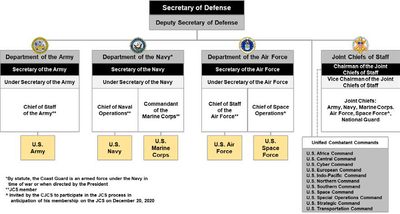
The military head of the Space Force is the Chief of Space Operations (CSO), who is an officer in the grade of general. The Chief of Space Operations will become a member of the Joint Staff one year after the passage of the United States Space Force Act. If authorized by the Secretary of Defense, the Chief of Space Operations may be dual-hatted as the Commander of United States Space Command.[9]
The Space Force is intended to include all uniformed and civilian personnel within the Department of Defense conducting and supporting space operations, centralizing management of space professionals. The Space Force will also create career paths for military and civilian space personnel, to include operations, intelligence, engineering, science, acquisitions, and cyber. While establishing the Space Force, the Defense Department intends to utilize inter-service transfers, initial lateral entry, direct commission authorities, career incentive pays and retention bonuses, and waivers to accession policy.[9][10]
Air Force Space Command (AFSPC) was redesignated as the Space Force by the 2020 NDAA, elevated to become the new service. All of AFSPC's former personnel, organizations, and components were then assigned to the Space Force. At the time of the Space Force's independence, AFSPC's principal components were the 14th Air Force, which controlled operations, and the Space and Missile Systems Center, which is responsible for research and acquisitions.
The first organizational change occurred on 20 December 2019, when the Fourteenth Air Force/Air Forces Strategic was redesignated as Space Operations Command (SpOC). Major General John E. Shaw, former Commander, Fourteenth Air Force, was redesignated as Commander, Space Operations Command; in addition to Shaw's role as U.S. Space Command's Combined Force Space Component Commander.[11]
The Space Force is also intending to stand up a space systems command and a space training and readiness command. A space systems command is intended to centralize Space Force launch, procurement, research, and development activities, while a space training and readiness command is intended to grow a cadre of space professionals and be comprised of Space Force Centers focused on training, readiness, and doctrine.[7][12]
Structure
Space Operations Command (SpOC), Vandenberg Air Force Base, California
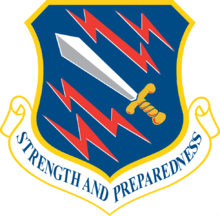
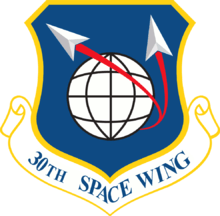


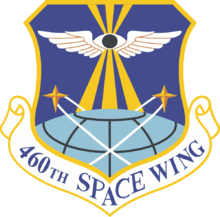
.jpg)
![]()
As of mid-2019, as regards actual satellites in orbit being operated and controlled by the then-AFSPC, the Air Force reported that there were four Advanced Extremely High Frequency communications; one ATRR; five Defense Meteorological Satellite Program; six Defense Satellite Communications System satellites; five Defense Support Program; 31 Global Positioning System satellites; four GSSAP; five Milstar communications; seven Space-Based Infrared System (SBIRS, infra-red, launch warning); two SBSS; and seven WGS.[13] The Boeing X-37B and its low-profile missions also represent a significant U.S. orbital asset. The fifth and latest X-37 mission, USA-277, was launched on 7 September 2017, and was the longest X-37 mission to date,[14] landing on 27 October 2019 after 780 days in orbit.[15][16]
On 12 March 2019, the Space Development Agency (SDA), a new space-focused development agency, additional to the Space and Missile Systems Center and the Space Rapid Capabilities Office, was established.[17] It was established under the authority of the Under Secretary of Defense for Research and Engineering.[18] As of January 2020, the SDA is planned to become part of the U.S. Space Force in October 2022.[19]
In early April 2020, a list of twenty-three units to be transferred from the Air Force to the Space Force was publicly reported.[20] Those units included the 17th Test Squadron, Peterson Air Force Base, Colorado; 18th Intelligence Squadron, Wright-Patterson AFB, OH; the 25th Space Range Squadron, Schriever AFB, CO; the 328th Weapons Squadron, Nellis AFB, NV; the 527th Space Aggressor Squadron, Schriever AFB, CO; Operating Location A, 705th Combat Training Squadron, Schriever AFB, Colorado (ultimately part of the 505th Command and Control Wing); the 7th Intelligence Squadron, 659th Intelligence, Surveillance and Reconnaissance Group, 70th ISR Wing, Ft. Meade, Maryland*; Sixteenth Air Force/Advanced Programs*, Schriever AFB, Colorado; the 32nd Intelligence Squadron, Ft. Meade, Maryland*; the 566th Intelligence Squadron, Buckley AFB, Colorado*; the 544th Intelligence, Surveillance and Reconnaissance Group, Group Staff & Detachment 5, Peterson AFB, Colorado; Detachment 1, USAF Warfare Center, Schriever AFB, Colorado; the 533d Training Squadron, 381st Training Group, Vandenberg AFB, CA (initial training); the National Security Space Institute, Peterson AFB, CO National Security Space Institute, a place for space education; the Air Force Research Laboratory (AFRL) Research Lab Mission Execution, Wright-Patterson AFB, Ohio*; the AFRL Space Vehicles Directorate, Kirtland AFB, New Mexico*; the AFRL Rocket Propulsion Division, Edwards AFB, CA; the AFRL Electro-Optical Division, Maui, Hawaii & Kirtland AFB, New Mexico*; the AFRL Sensors Directorate, Wright-Patterson AFB, Ohio*; the Counter-Space Analysis Squadron and the Space Analysis Squadron, collectively half of the Space and Missiles Analysis Group, National Air and Space Intelligence Center, both at Wright-Patterson AFB; the Air Force Operational Test and Evaluation Center Detachment 4, Peterson AFB, CO; and the Air Force Safety Center – Space Safety Division, Kirtland AFB, New Mexico.
Personnel
All members of the former Air Force Space Command are currently assigned to the Space Force. Members of the Army and Navy will also be detailed to the Space Force.[21] There are currently 16,000 individuals assigned to the Space Force.[3] Air Force airmen will begin transferring to the Space Force beginning in FY 2020, while Army soldiers and Navy sailors will begin transferring in FY 2022.[7] The FY 2021 budget allocates 10,000 civilian and military billets to the USSF.[22]
The Space Force is creating career tracks for Space Force Core Organic specialties, including space-specific operations, intelligence, engineering, acquisitions, science, and cyber/communications. Support specialties, such as legal, medical, civil engineering, logistics, financial management, security forces, and public affairs will be detailed by the Air Force to support the Space Force.[7]
Officers and enlisted personnel
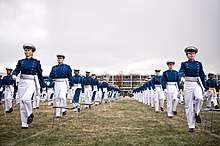
All members of the Space Force currently retain their respective grade and rank carried over from the Air Force. However, it has not yet announced what the permanent rank structure will be.[21][23]
Space Force officers are accessed through the United States Air Force Academy, Air Force Reserve Officer Training Corps, and Air Force Officer Training School. Enlisted personnel are accessed through Air Force Basic Military Training, although some of the curriculum may be modified to be more space-related. The Space Force is also leveraging the Air Force's infrastructure, curriculum, and instructors for initial training, while creating space-specific training programs as well.[7]
The Space Force recently announced that it will be absorbing 16 integral specialties.[24]
Officer specialties include:
- 13S - Space Operations Officer
- 14N - Intelligence Officer
- 17D - Cyberspace Operations Officer
- 17S - Cyber Warfare Operations Officer
- 62E - Developmental Engineer
- 62S - Materiel Leader
- 63A - Acquisition Manager
- 63G - Senior Materiel Leader-Lower Echelon
- 63S - Materiel Leader
Enlisted specialties include:
- 1C6 - Space Systems Operations specialist
- 1N0 - All Source Intelligence Analyst
- 1N1 - Geospatial Intelligence Analyst
- 1N2 - Signals Intelligence Analyst
- 1N4 - Fusion Analyst
- 3D0 - Cyberspace Operations specialist
- 3D1 - Cyberspace Systems specialist
Uniforms

While the Space Force develops its own set of distinctive uniforms, it is using the Air Force's service dress uniform and has adopted the OCP uniform as its own combat utility uniform.[23]
Awards and badges
In addition to basic uniform clothing, various insignia are used by the USSF to indicate a billet assignment or qualification-level for a given assignment. Insignia currently in use by the USSF include the United States Space Command identification badge and the Command Space Operations badge.[25]
Equipment
The USSF operates both of the X-37 spaceplanes currently in the DOD inventory, although it contracts out for launches. The first flight operated by the USSF of the X-37 was OTV-6, on May 17, 2020 on an Atlas V.[26]
Budget
The proposed Fiscal Year 2021 budget for the Space Force would transfer over $15 billion from the Air Force.[22]
| United States Space Force Budget[22] | 2020 | 2021 (proposed) |
|---|---|---|
| Operation & Maintenance | $40,000,000 | $2,608,400,000 |
| Procurement | - | $2,446,100,000 |
| Research, Development, Test & Evaluation | - | $10,327,600,000 |
| Total | $40,000,000 | $15,382,100,000 |
The 2021 Department of Defense Budget requests $1.6 billion for three National Security Space Launch vehicles.[27] $1.05 billion of this budget will fund three launches: AFSPC-36, AFSPC-87 and AFSPC-112.[28] The United States Space Force is reported to be working closely with commercial leaders in the space domain such as Elon Musk (SpaceX) and Jeff Bezos (Blue Origin) to determine their capability in serving the mission. According to Lt. General David Thompson, the United States Space Force is already in contracting talks with Blue Origin.[29] The budget includes $560 million to upgrade the launch systems of Blue Origin, Northrop Grumman, and United Launch Alliance.[28] Further, the 2021 DOD budget requests $1.8 billion for two Lockheed Martin Global Positioning System (GPS) III systems and other projects to fulfill the Space Superiority Strategy.[27] The GPS III system, first launched on 23 December 2018, is the latest GPS system from contractor Lockheed Martin; the GPS III system has improved anti-jamming capabilities and is three times more accurate than current GPS systems.[30] The FY 2021 Budget also includes $2.5 billion allocated to the Next-Generation Overhead Persistent Infrared (Next-Gen OPIR) satellite constellation as part of a DOD wide increase on missile defense capacity to defend from threats such as North Korea.[22] The Next-Gen OPIR constellation will provide the U.S. military with a resilient worldwide missile warning system.[31] This new generation of satellites will work in tandem with the existing Space Based Overhead Persistent Infrared System (SBIRS); production of the SBIRS will conclude in 2022 and the first Next-Gen OPIR satellite is expected to be delivered in 2025.[28]
History
Early military space program (1945–1982)
Military space activities began immediately after the conclusion of World War II, with General of the Army Hap Arnold, commanding general of the United States Army Air Forces, becoming an early visionary for the potential of military space operations. In 1946 General Arnold directed Dr. Theodore von Kármán of the RAND Corporation to determine the feasibility of a satellite for strategic reconnaissance. In 1946 this study identified nearly all current space mission areas, including intelligence, weather forecasting, communications, and navigation.[32]

After the United States Air Force gained its independence in 1947, General Bernard Schriever was appointed to head the Western Development Division, made responsible for the Air Force's space and intercontinental ballistic missile programs. It was responsible for developing the Advanced Reconnaissance System, which would have been the Air Force's first satellite constellation. On 4 October 1957 the Soviet Union launched Sputnik 1, which was the world's first satellite. This event transformed space development overnight, helping the national security establishment understand the importance of the space domain.[32]
Early military space development was marked by strong interservice rivalry, with each developing their own proposals for satellites and launch vehicles. The first American satellite was the Army Ballistic Missile Agency's Explorer 1 which was launched on the Naval Research Laboratory's Vanguard rocket. The Air Force still continued military space development amidst this competition from the Army and Navy. In 1958 the newly formed Advanced Research Projects Agency assumed control over all military space programs, but this centralization was short lived and gave control back to the services in September 1959. The creation of NASA in 1958 significantly hampered the Army and Navy's space programs, absorbing the Army's Jet Propulsion Laboratory and Army Ballistic Missile Agency and Navy's Project Vanguard and Minitrack satellite tracking network, but only absorbed the Air Force's Man in Space Soonest program, merging it with Project Mercury.[32]
Development of Air Force space systems continued with the Missile Defense Alarm System (MIDAS) and Strategic Air Command's SAMOS reconnaissance satellites, as well as the Thor, Atlas, and Titan space launch vehicles. The Air Force and Central Intelligence Agency also jointly developed and operated the Corona reconnaissance satellite. The development of reconnaissance satellites became a national priority after an American U-2 reconnaissance plane was shot down over the Soviet Union, making aerial reconnaissance impractical. In 1961 the National Reconnaissance Office was created as a joint Air Force–CIA activity to manage all spy satellites.[32]
— John F. Kennedy, speech at Rice University, 12 September 1962[33]
In 1961, Secretary of Defense Robert McNamara designated the Air Force as the lead military service for space, further relegating the space programs of the Army and Navy. The relationship between the Air Force space program and NASA continued to grow closer, with agreements being reached to share information and personnel. The Air Force also began development on the crewed Boeing X-20 Dyna-Soar spaceplane and Manned Orbiting Laboratory, both of which were later canceled as their functions could be carried out by uncrewed systems. General Schriever's advocacy for military space led to the 1961 establishment of Air Force Systems Command (AFSC), which included a dedicated Space Systems Directorate to centralize all space development, separating it from the missile program. Prior to Air Force Systems Command's creation, spacecraft design, acquisitions, and launch was split between Air Material Command and Air Force Research and Development Command, however, the new command centralized all of these activities.[32]
The Air Force provided space support to forces during the Vietnam War, with a focus on providing space–based weather and communications capabilities. In the 1970s development began on the Global Positioning System, Defense Satellite Communications System, and Defense Support Program missile warning satellites. The Space Shuttle also began development, with significant Air Force input. For much of the 1960s and 1970s, Air Force space operations were centralized in Aerospace Defense Command, but it was disestablished in 1980, transferring its space surveillance and missile warning systems to Strategic Air Command. In 1979, Air Force doctrine recognized space as a mission area for the first time, and led to the creation of a space division on the Air Staff. Air Force Systems Command also established a deputy commander for space operations.[32]
Air Force Space Command (1982–2019)
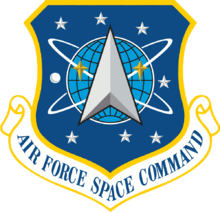
Towards the 1980s, the Air Force began to realize that it was insufficiently organized for military space operations, with assets and responsibilities split across Strategic Air Command, Air Force Systems Command, the Aerospace Defense Center, and the Air Staff. In 1979, the Air Force Scientific Advisory Board concluded that "currently, the Air Force is inadequately organized for operational exploitation of space and has placed insufficient emphasis on inclusion of space systems in an integrated force study." In 1981, the Air Force took a measure to address this discontinuity, establishing the consolidated space operations center in Colorado Springs and began discussing the creation of a space command to centralize its space activities. On 1 September 1982, Air Force Space Command (AFSPC) was created as an Air Force major command.[32] Air Force Space Command centralized all space operations, including missile warning, launch operations, satellite control, space domain awareness, and satellite communications.[6]
Air Force Space Command was absolutely critical during the Persian Gulf War, which would later be described as the first space war by Air Force Chief of Staff General Merrill McPeak. Specifically, its GPS support enabled the left hook across the Iraq desert.[6] Defense Meteorological Support Program satellites provided a significant amount of weather data and over 90% of communications were provided by satellite systems. The Defense Support Program early-warning satellites provided indications of SCUD launches to fielded forces.[32]
In the 1990s, AFSPC led the development of the MILSTAR communications satellite constellation and completed the GPS constellation.[32] In accordance with the recommendations of the 2001 Space Commission, the Space and Missile Systems Center was transferred from Air Force Material Command to Air Force Space Command, becoming its integral research and acquisitions arm. In the aftermath of the September 11 attacks, Air Force Space Command provided space support as part of the global war on terrorism.[34]
Independence (2019–present)
The idea of an independent service for U.S. military space operations had been under consideration since 2000. The Commission to Assess United States National Security Space Management and Organization, chaired by former secretary of defense Donald Rumsfeld and composed of a number of military, space, and intelligence professionals, was set up to examine the national security space organization of the United States. The commission itself concluded that the military needed to develop space–specific doctrine, operations concepts, and capabilities – including the development and deployment of space–based weapons. The Space Commission came to the conclusion that the Air Force treated space operations as a secondary mission in comparison to air operations, and recommended the creation of a space corps within the Department of the Air Force, and in the long term, creating a military department for space.[37]
.jpg)
In 2017, a bipartisan proposal to create the U.S. Space Corps, as a military service within the Department of the Air Force, was put forward by Representatives Mike Rogers and Jim Cooper. This was done specifically due to the realization that the Air Force's space mission had become a secondary concern in contrast with the air dominance mission.[38] The proposal passed in the House of Representatives, but was cut from the final bill in negotiations with the U.S. Senate.[39]
The proposal gained new life when President Donald Trump first publicly spoke about an independent space force during a March 2018 speech.[40] In a June 2018 meeting of the National Space Council, he directed the Department of Defense to begin the necessary processes to establish the U.S. Space Force as a branch of the Armed Forces.[41] On 19 February 2019, Space Policy Directive–4 was signed, initially calling for the placement of the U.S. Space Force within the Department of the Air Force, before later creating and transferring the service to the Department of the Space Force.[42] Legislative provisions for the Space Force were included in the 2020 National Defense Authorization Act, which was signed into law by President Donald Trump during a signing ceremony at Joint Base Andrews on 20 December 2019. The Space Force was established as the sixth armed service branch, with Air Force General John "Jay" Raymond, the head of Air Force Space Command and U.S. Space Command, becoming the first Chief of Space Operations.[43] On 14 January 2020, Raymond was officially sworn in as chief of space operations by Vice President Mike Pence.[44] Air Force Secretary Barbara Barrett approved the transfer of 14th U.S. Air Force to the Space Force and re-designated as Space Operations Command, with the transfer effective 20 December 2019.[45] The former commander of the 14th Air Force, Maj. Gen. John E. Shaw, was appointed commander of Space Operations Command while also serving as U.S. Space Command's Combined Force Space Component commander.[46]
About 16,000 Air Force active duty and civilian personnel are to be assigned to the Space Force while the branch is gradually integrated into the U.S. Armed Forces, including establishing independent procedures for manning equipment, training personnel, and creating uniforms, ranks, logo, patch, awards, and official song, reportedly within an 18-month period.[47] 1,840 billets from 23 units of the Air Force are being transferred to the Space Force in 2020.[48][49] On 18 April 2020, 86 graduates of the United States Air Force Academy became the first group of commissioned second lieutenants in the U.S. Space Force.[50][51] The force's flag debuted at signing ceremony for the 2020 Armed Forces Day proclamation on 15 May 2020 and is based on the service's official seal.[52]
The Space Force's first space launch was on 26 March 2020 with the AEHF-6 communications satellite launching from Cape Canaveral Air Force Station. Patrick Air Force Base, Schriever Air Force Base, Peterson Air Force Base and Buckley Air Force Base, are expected to have their name changed as they have mostly space-related missions.[53]
See also
- Militarization of space
- Space National Guard
- Strategic Defense Initiative
References
- "U.S. Space Force Fact Sheet". Spaceforce.mil. United States Space Force. 20 December 2019. Retrieved 21 December 2019.
- Dickstein, Corey (15 May 2020). "Space Force unveils its service flag at White House ceremony". Stars and Stripes. Retrieved 16 May 2020.
Last month, the service increased from just two official members — Raymond and Towberman — to 88, when it added 86 second lieutenants who commissioned into the branch from the Air Force Academy.
- "What's the Space Force". spaceforce.mil.
- https://www.airforcemag.com/app/uploads/2020/06/Spaceforce.pdf
- "Fact Sheet". www.spaceforce.mil. Retrieved 27 January 2020.
- "Fact Sheet". spaceforce.mil.
- "Comprehensive plan for the Organizational structure of the US Space Force" (PDF). velosteam.com. 2020. Retrieved 26 March 2020.
- "National Defense Authorization Act for Fiscal Year 2020" (PDF). United States House of Representatives. December 2019.
- U.S. Department of Defense (February 2019). "United States Space Force Strategic Overview" (PDF). defense.gov. Retrieved 11 May 2019.
- U.S. Government (19 February 2019). "Space Policy Directive-4: Establishment of the United States Space Force" (PDF). defense.gov. Retrieved 11 May 2019.
- "14th Air Force Redesignated as Space Operations Command". United States Space Force.
- "Space Force May Bring Launch Wings Under Systems Command". 12 February 2020.
- "Air Force Almanac 2019: Major Commands and National Guard" (PDF). Washington DC.: Air Force Association. 29 May 2019. Cite magazine requires
|magazine=(help) - Novak, Matt (27 August 2019). "Secretive U.S. Air Force Spaceplane Breaks Record With 719 Straight Days in Orbit". Gizmodo. Retrieved 27 August 2019.
- Clark, Stephen (27 October 2019). "U.S. military's X-37B spaceplane lands in Florida". Spaceflight Now. Retrieved 28 October 2019.
- Gallop, J. D. (27 October 2019). "U.S. Airforce's X-37B returns to Earth with a 'boom' and a new record for spaceflight". USA Today. Florida Today. Retrieved 28 October 2019.
- Browne, Ryan (13 March 2019). "Pentagon launches development agency seen as key to future Space Force". CNN. Retrieved 22 January 2020.
- See https://www.cto.mil/ (accessed May 2020).
- Valerie Insinna (21 January 2020). "Space Development Agency on track to become part of Space Force in 2022, director says". Defense News. Retrieved 15 May 2020.
- Erwin, Sandra (31 March 2020). "U.S. Air Force to transfer 23 units to the Space Force". SpaceNews.com.
- "How will the Space Force impact me". spaceforce.mil.
- "Defense Budget Overview" (PDF).
- Seck, Hope Hodge (17 January 2020). "Space Force Offers First Peek at Camouflage Uniform". Military.com.
- Seck, Hope Hodge (3 March 2020). "Here Are the 16 Jobs that Will Be Available to Troops in US Space Force". Military.com.
- Seck, Hope Hodge (17 January 2020). "Space Force Offers First Peek at Camouflage Uniform". Military.com. Retrieved 27 January 2020.
- Insinna, Valerie (17 May 2020). "US Space Force launches the mysterious X-37B space plane". Retrieved 30 May 2020.
- "DOD Releases Fiscal Year 2021 Budget Proposal". U.S. DEPARTMENT OF DEFENSE. Retrieved 23 February 2020.
- "Space Force's 2021 budget plan is heavy on satellites and launch". SpaceNews.com. 6 March 2020. Retrieved 12 March 2020.
- Giangreco, Leigh (25 February 2020). "Space Force's Second-in-Command Explains What the Hell It Actually Does". Medium. Retrieved 12 March 2020.
- "GPS Satellites". Lockheed Martin. Retrieved 12 March 2020.
- "Next Generation Overhead Persistent Infrared GEO Satellites Embracing". Air Force Space Command. Retrieved 12 March 2020.
- "The U.S. Air Force in Space 1945 to the Twenty-first Century" (PDF). Washington, D.C.: USAF History and Museums Program, United States Air Force. 1998.
- JFK Library, Address at Rice University, September 12, 1962 (USG 15 29) on YouTube, Houston, Texas, concerning the nation's efforts in space exploration, minutes 7:16–8:00.
- "Air Force Space Command". Air Force Space Command.
- "United States Space Force". www.facebook.com. Retrieved 27 January 2020.
- "United States Space Force (@SpaceForceDoD) | Twitter". twitter.com. Retrieved 27 January 2020.
- U.S. Government (10 January 2001). "Report to the Commission to Assess United States National Security Space Management and Organization" (PDF). csis.org. Retrieved 11 May 2019.
- "Congressman Rogers: A space corps is 'inevitable'". SpaceNews.com. 2 December 2017. Retrieved 2 January 2019.
- "Space Corps Crashes to Earth in Negotiated Defense Bill". Defensetech.org. 8 November 2017.
- Koren, Marina (13 March 2018). "What Does Trump Mean By 'Space Force'?". The Atlantic.
- "Remarks by President Trump at a Meeting with the National Space Council and Signing of Space Policy Directive-3". White House. 18 June 2018. Retrieved 11 August 2018.
- "Space Policy Directive 4". spaceforce.mil.
- CNN, Ryan Browne (20 December 2019). "With a signature, Trump brings Space Force into being". CNN. Retrieved 21 January 2020.
- "New Space Force uniforms are camo, but why?". ABC12.com. CNN\Gray News. 18 January 2020. Retrieved 21 January 2020.
- "14th Air Force now designated as U.S. Space Operations Command". UPI. 30 December 2019. Retrieved 21 January 2020.
- Jacobson, Willis (27 December 2019). "Vandenberg Air Force Base hosting key command in support of new Space Force". Santa Maria Times. Retrieved 22 January 2020.
- "The Space Force is officially the sixth military branch. Here's what that means". Air Force Times. 20 December 2019. Retrieved 21 December 2019.
- https://breakingdefense.com/2020/03/air-force-to-transfer-missions-from-23-units-to-space-force/
- Hitchens, Theresa (31 March 2020). "Air Force To Transfer Missions From 23 Units To Space Force". Breaking Defense. Retrieved 16 June 2020.
- Erwin, Sandra (18 April 2020). "U.S. Space Force adds 86 new officers after academy graduation". SpaceNews.com. Retrieved 16 June 2020.
- https://spacenews.com/u-s-space-force-adds-86-new-officers-after-academy-graduation/
- Cathey, Libby (15 May 2020). [>https://abcnews.go.com/Politics/trump-presented-official-space-force-flag-military-officials/story?id=70701100 "Trump presented with Space Force flag by military officials in Oval Office"] Check
|url=value (help). ABC News. Retrieved 16 June 2020. - Defense, U. S. Dept of (29 March 2020). "Top Space Officer: Launch of Space Force Largely Unaffected by Coronavirus". SciTechDaily. Retrieved 16 June 2020.
External links
| Wikimedia Commons has media related to United States Space Force. |
| Library resources about United States Space Force |
- Official website

- "US Space Force Recruitment Video". US Space Force via Storyful. 6 May 2020.
- 20170622 Markup of HR2810 FY18NDAA — Strategic Forces (ID: 106134) U.S. House Armed Services Committee on YouTube
- H.R.2810 — National Defense Authorization Act for Fiscal Year 2018 — House version, United States Congress
- S.1519 — National Defense Authorization Act for Fiscal Year 2018 — Senate version, United States Congress
- Final Report on Organizational and Management Structure for the National Security Space Components of the Department of Defense
